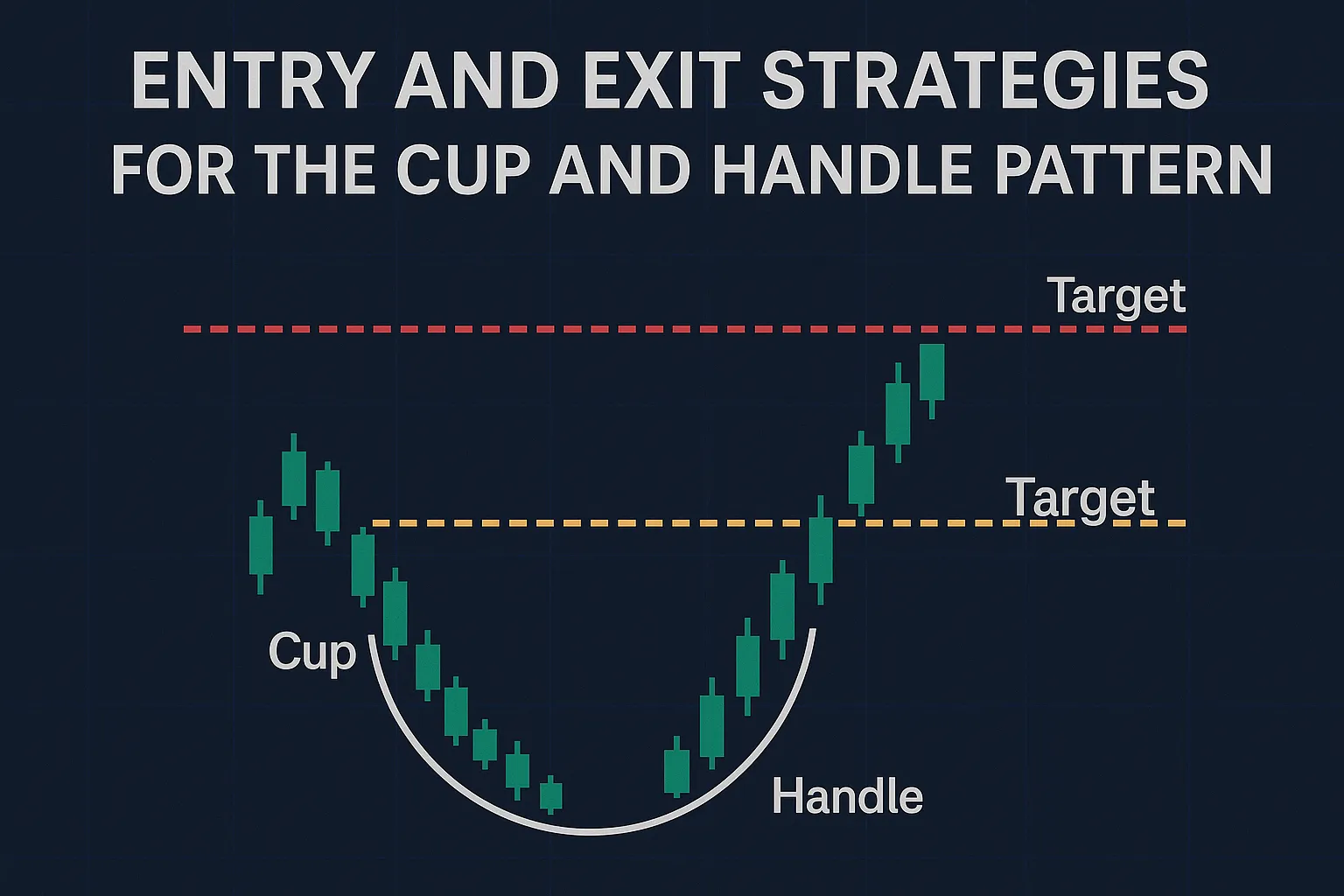
Introduction
Mastering entry and exit cup and handle strategies is key to trading this bullish chart pattern successfully. The cup and handle signals strong price increases, but knowing when to enter and exit trades ensures you capture profits while minimizing risks. Whether you’re trading stocks, forex, or cryptocurrencies, precise timing can make all the difference. This guide outlines effective entry and exit strategies for the cup and handle pattern, offering practical steps to boost your trading performance.
What is the Cup and Handle Pattern?
The cup and handle pattern is a bullish continuation chart pattern that forms after a price uptrend. It includes:
- Cup: A U-shaped consolidation, resembling a bowl, lasting 1–6 months.
- Handle: A short, downward-sloping pullback, lasting 1–4 weeks.
The pattern is confirmed when the price breaks above the handle’s resistance with high volume, signaling a potential price rise. Strategic entry and exit points are critical for capitalizing on this breakout.
Why Entry and Exit Strategies Matter
Well-timed entry and exit strategies help traders:
- Maximize Profits: Enter at the right moment to ride the breakout and exit near the target.
- Minimize Losses: Avoid false breakouts and secure gains before reversals.
- Stay Disciplined: Follow a plan to avoid impulsive decisions driven by market noise.
Effective strategies align with the pattern’s breakout dynamics and market conditions.
Entry Strategies for the Cup and Handle Pattern
Here’s how to time your entry for a cup and handle trade:
1. Breakout Entry
- When: Enter after the price closes above the handle’s resistance (the cup’s peak) on high volume.
- Why: This confirms the breakout, signaling strong bullish momentum.
- Example: If a stock’s cup peaks at $100, with a handle at $95, buy when the price closes above $100 with a volume spike.
2. Pullback Entry
- When: Wait for a slight pullback to the breakout level (e.g., $100) after the initial breakout.
- Why: This offers a lower-risk entry, as the price retests support before continuing upward.
- Tip: Ensure the pullback occurs on low volume, indicating no significant selling pressure.
3. Confirmation with Indicators
- Use indicators like RSI or MACD to confirm entry:
- RSI below 70 suggests the breakout isn’t overbought.
- A bullish MACD crossover supports upward momentum.
- Combine with volume to validate the breakout’s strength.
Exit Strategies for the Cup and Handle Pattern
Plan your exit to lock in profits or limit losses:
1. Price Target Exit
- How: Calculate the target by adding the cup’s depth (peak to trough) to the breakout point.
- Example: A cup from $100 to $80 (depth $20) with a breakout at $100 targets $120 ($100 + $20).
- Exit at the target or take partial profits if resistance appears.
2. Trailing Stop Exit
- How: Use a trailing stop to capture gains if the price exceeds the target.
- Why: This protects profits in strong bullish markets while allowing for extra upside.
- Set the stop 5–10% below the current price, adjusting as the price rises.
3. Early Exit on Weakness
- When: Exit if the breakout stalls, volume fades, or indicators signal overbought conditions (e.g., RSI > 70).
- Why: This prevents losses from reversals or failed breakouts.
Common Mistakes to Avoid
- Entering Too Early: Trading during the handle risks losses if the breakout fails.
- Ignoring Volume: Low-volume breakouts often lead to reversals.
- Holding Too Long: Failing to exit at the target or on weakness can erase gains.
Tools and Resources
Refine your entry and exit strategies with these resources:
- TradingView: Set alerts for breakouts and track price targets. Visit TradingView.
- Investopedia: Learn about trading strategies and risk management. Read on Investopedia.
- BabyPips: Explore entry and exit techniques for forex trading. Explore BabyPips.
Tips for Traders
- Test Strategies: Practice entries and exits on demo accounts to build confidence.
- Monitor Volume: Ensure high volume on breakouts and low volume on pullbacks.
- Use Indicators: Combine RSI, MACD, or moving averages for stronger signals.
- Plan Ahead: Define entry, exit, and stop-loss levels before trading.
FAQ Section
Q: When is the best time to enter a cup and handle trade?
A: Enter after a high-volume breakout above the handle’s resistance or on a low-volume pullback to the breakout level.
Q: How do I know when to exit a cup and handle trade?
A: Exit at the price target (cup depth added to breakout), use a trailing stop, or exit early if momentum weakens.
Q: What is a good stop-loss for entry and exit cup and handle trades?
A: Place a stop-loss below the handle’s low to protect against false breakouts.
Q: Do entry and exit strategies work in crypto trading?
A: Yes, but crypto volatility requires tighter stops and careful volume analysis.
Q: Can indicators improve entry and exit for cup and handle trades?
A: Yes, RSI and MACD can confirm breakout strength and signal optimal exit points.
Conclusion
Effective entry and exit cup and handle strategies are essential for profitable trading. By timing entries with breakouts or pullbacks, setting clear exits with targets or trailing stops, and confirming with volume and indicators, you can succeed in stocks, forex, and crypto. Use tools like SAPRO to refine your approach. For more trading insights, visit https://cupandhandlepattern.com/.





Leave a Reply